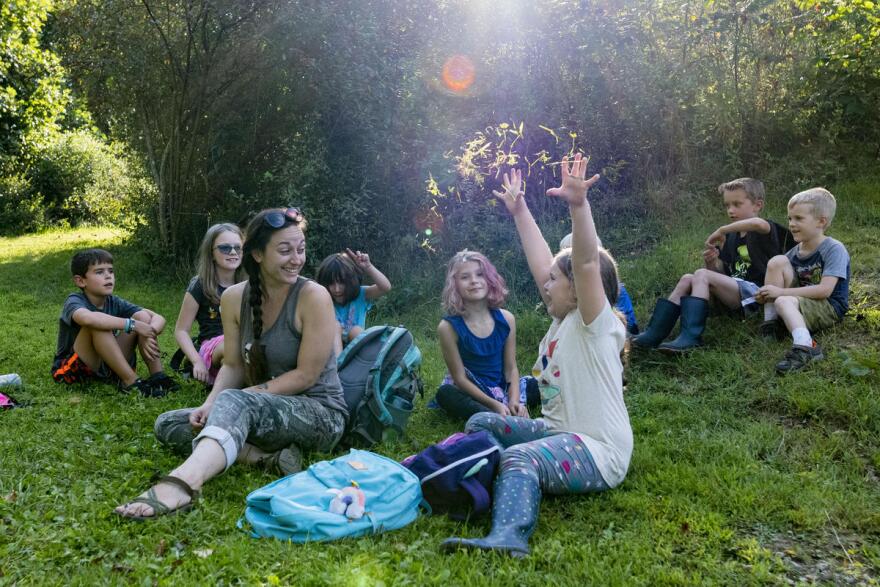Increasingly, teachers are finding that spending time in nature with their students is essential to learning. In this week’s episode of Inside Appalachia, we’ll hear from educators who are knocking down classroom walls so that kids can get some fresh air and exercise, and improve test scores in the process.
“I think there’s a difference between opening up a science textbook and learning about water quality when you can go outside and be in your own watershed,” Hannah Spencer said. Spencer is a co-founder of the Mountain Stewardship and Outdoor Leadership school, or Mountain SOL, an outdoor education program based in Morgantown.

Teaching outside might not solve all the underlying issues that make education challenging. But research shows that offering children outdoor learning opportunitiesimproves test scores. And for kids struggling with attention disorders,it can be as effective as therapy and medication.
Author and researcher Florence Williams points out that kids in the U.S. today, “spend half as much time outdoors as their parents did. Instead, they spend up to seven hours a day on screens, not including time in school.”
A review of 13 scientific studies published this year in BMJ Open found that “there is evidence that higher levels of screentime is associated with a variety of health harms” for children and young people, “with evidence strongest for adiposity, unhealthy diet, depressive symptoms and quality of life. There is also evidence that high screentime is associated with deleterious effects on irritability, low mood and cognitive and socioemotional development, leading to poor educational performance.”
The American Academy of Pediatrics recommends that parents should place consistent limits on their children’s screen time (television, phones, computers, all devices).
One possible bright spot in all this is that here in Appalachia, we have an abundance of nature. It can provide a ready-made opportunity to teach kids about the ways industry and pollution can affect the environment. And it can nurture their curiosity. All we have to do is walk outside.
A Place Outdoors For Children With Parents Who Struggle With Addiction
In West Virginia and across the nation, many school systems are struggling to teach kids who are dealing with complicated, often dysfunctional home lives.
But kids often form strong bonds in outdoor settings, and they make connections with other children based on shared experiences, outside of their own homes. It’s almost like a temporary reset button on their lives. For children with troubled home lives, these experiences can be even more powerful and life changing. A group in Ohio has tuned into this idea that kids find coping mechanisms more readily in natural environments. Kavitha Cardoza reports about one program set outdoors in Dayton, Ohio, that hosts children whose parents struggle with addiction.
Outdoor Learning Can Happen In Cities, Too
Many stories in this episode take place in communities that border national forests, with access to an abundance of trees and other wild plants and animals. But you don’t need pristine and remote landscapes to reap the benefits of going outside. Sure, scientists haveidentified that soils and trees emit chemicals known to improve immune function and even help prevent cancer -- but sometimes justwalking through your own community can inspire learning and engagement. WFPL’s Liz Schlemmer reports from the parking lot at Louisville Male High School, where science teachers and students are tackling tough subjects like climate change.
Outdoor Academy At Boy Scout Jamboree
If you were in southern West Virginia this summer, you may have run into scouts who were visiting from across the globe. Tens of thousands of young scouts from more than 150 countries converged in rural southern West Virginia for the 24th World Scout Jamboree, temporarily creating the state’s second-largest city. Glynis Board reports it’s the first time the event has come to the U.S. since 1967.
 Glynis Board interviewed scouts from South America and all over the world during the World Scout Jamboree.
Glynis Board interviewed scouts from South America and all over the world during the World Scout Jamboree.
Credit Courtesy Boy Scouts of America
The Boy Scouts of America welcomed scouts and astronauts alike, and now they’re teaming up with West Virginia University to tackle an ambitious goal — getting all sixth-graders in West Virginia learning outside. Glynis Board went back down to the scouts’ high-adventure property this fall to visit organizers, teachers and students participating in the pilot program.

Our energy and environment reporter, Brittany Patterson, guest hosts this episode. She closes the show with these personal thoughts:
“Sometimes my job reporting on the environment is really tough. Reporting about all the things in our environment that are making us sick, or could be making us sick, and what’s at stake can be, well, very overwhelming.”
“But then, I also get to visit foresters who know trees like they’re family, hike through rare bogs, finding plants that have been here since the ice age, and breathe in mist from raging mountain waterfalls. My job is awesome because of these super-beautiful, life-giving moments.
And watching kids have those moments, experiencing the outdoors is like honey for my soul. So remember — having a bad day? Go outside. Find yourself hyper-distracted? Try going outside. Your kid is having a hard time focusing? Send him to breathe outside for a couple minutes. It’s worth a try. Trust me.” — Brittany Patterson.
Loading...
We had help producing Inside Appalachia this week from NPR’s All Things Considered and WFPL in Louisville.
Our theme music is by Matt Jackfert. Other music this week was provided by Dinosaur Burps.
Roxy Todd is our producer.Eric Douglas is our associate producer. Our executive producer isJesse Wright. Glynis Board edited our show this week. Our audio mixer is Patrick Stephens. You can find us on Twitter@InAppalachia. You can also send us an email to Inside Appalachia@wvpublic dot org.




